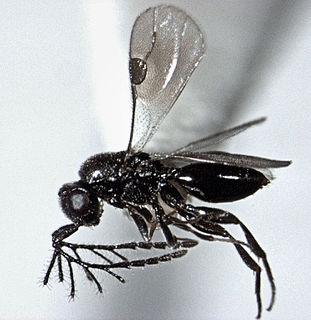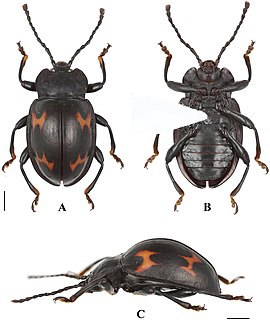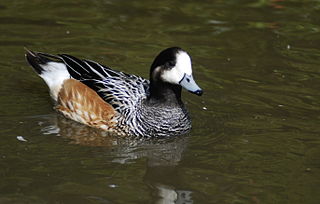
Gustav von Paykull was a Swedish friherre and Marshal of the Court, ornithologist, and entomologist.

The Megaspilidae are a small hymenopteran family with 13 genera in two subfamilies, and some 450 known species, with a great many species still undescribed. It is a poorly known group as a whole, though most are believed to be parasitoids, and a few hyperparasitoids. Many are found in the soil, and of these, a number are wingless.

Agabus is a large genus of predatory aquatic beetles in the family Dytiscidae, proposed in 1817 by William Elford Leach and named after Agabus, an early follower of Christianity. The adult beetles are moderate-sized, 5 to 14 mm long. The genus is primarily Holarctic in distribution, with only a few species known from the Afrotropical and Neotropical realms. Three species of Agabus, namely A. clypealis, A. discicollis and A. hozgargantae are endangered according to the IUCN Red List. The division into subgenera is not widely accepted. However, a number of species groups are recognized after the works of David J. Larson and Anders N. Nilsson. The genus is probably polyphyletic or paraphyletic. In a recent study of mitochondrial DNA, Agabus was found paraphyletic with respect to several of the species groups of Platambus, a closely related genus in the tribe Agabini. Lately the taxonomy of the genus has been revised, and some groups of species were transferred from Agabussensu stricto to other genera in the tribe Agabini.

Endomychidae, or handsome fungus beetles, is a family of beetles with representatives found in all biogeographic realms. There are around 120 genera and 1300 species. The family was established based on the type genus Endomychus, a genus erected in 1795 by Panzer which was applied to a species that Linnaeus called Chrysomela coccinea. As the common name suggests, Endomychidae feed on fungi. Crowson, in his influential treatment of the beetles, placed the family within the Cucujoidea. They have a tarsal formal of 4-4-4 or 3-3-3 and the wings lack a closed radial cell. The second antennal segment has a sensory appendage that is as long as the third antennal segment. The family has also been grouped with the Coccinellidae in a group called the Trimera for having pseudotrimerous tarsi. A 2015 molecular phylogeny study found that the Cucujoidea were found to be non-monophyletic and the Endomychidae was refined with the removal of the Anamorphinae from within the family and elevated to the status of a full family, Anamorphidae. Mycetaeinae and Eupsilobiinae were also found not to belong within the clades of the core Endomychidae, and likewise reclassified into the families Mycetaeidae and Eupsilobiidae.

Ophonus is a ground beetle genus native to the Palearctic, the Near East, the Nearctic and North Africa. It contains the following species in the following subgenera:

Melandryidae is a family of false darkling beetles in the order Coleoptera. There are at least 40 genera and 100 described species in Melandryidae.

Salpingidae or narrow-waisted bark beetles is a family of beetles in the superfamily Tenebrionoidea. The species are small, about 1.5 – 7 mm in length. The family is globally distributed and consists of about 45 genera and 300 species, which are generally found in the temperate regions of both hemispheres. The family is mainly associated with plants as well as with ascomycete and hyphomycete fungi. Some members of the family are associated with unusual habitats, like Aegialites and Antarcticodomus, which are found in coastal areas including the intertidal zone, with former feeding on algae.

Rozel is a place name describing two identically named vingtaines in the Channel Island of Jersey- the Vingtaine de Rozel of St Martin and the Vingtaine de Rozel of Trinity.

Abdera flexuosa is a species of false darkling beetle (Melandryidae). (Paykull, 1799)
Abdera hoffeinsorum is an extinct species of false darkling beetle in the genus Abdera. It was discovered in Baltic amber in 2014.
Cyphon is a genus of beetles belonging to the family Scirtidae.










